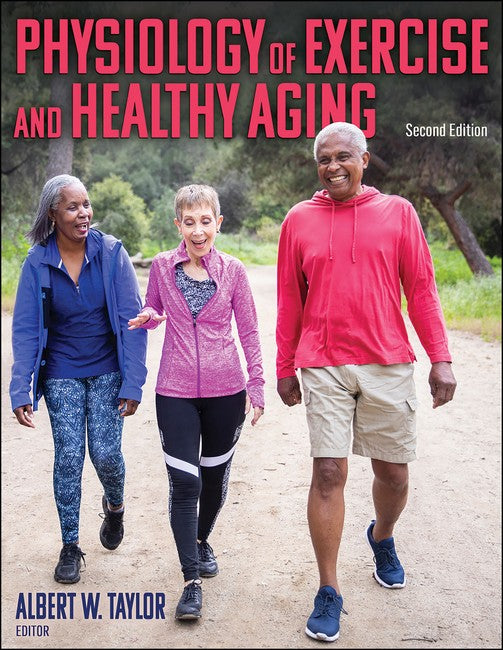Albert W. Taylor, PhD, DSc, retired from the University of Western Ontario in London, Ontario, Canada, where he taught courses on healthy aging and the physiology of aging. During his career, Taylor has published more than 400 research and professional articles and made over 500 presentations in more than 100 countries. In recognition of his research, Taylor has received honorary doctorates from Universite de Sherbrooke (Canada), London Institute for Applied Research (England), Semmelweis University (Hungary), and the Ukrainian State University of Physical Education and Sport (Ukraine). He also has been inducted into 10 halls of fame in recognition for his contributions to sport and science. Taylor is a fellow of the American College of Sports Medicine and has served as the president of both the Science and Sports Medicine Council of Canada and the Canadian Society for Exercise Physiology. Taylor received his PhD from Washington State University in 1967. He received the Honor Award from the Canadian Society for Exercise Physiology, a Certificate of Recognition for Contribution to Sport from the government of Ontario, and the International Wrestling Federation Pin of Merit.
Request Academic Copy
Please copy the ISBN for submitting review copy form
Description
Introduction Physical and Cognitive Changes With Aging The Process of Aging Aging and Homeostatic Processes Aging Demographics Theories of Aging Physical Activity and Aging Programming Recommendations Summary Part I. Physiological Systems, Age-Related Changes, and the Role of Physical Activity Chapter 1. Cardiopulmonary System Kevin Shoemaker and Patrice Brassard Structure and Function Age-Related Changes Cardiovascular Disease and Age Summary Chapter 2. Musculoskeletal System Kevin Milne, Matthew Krause, and Albert W. Taylor Muscle Morphology Age-Related Changes in Biochemical Properties Skeletal Muscle, Aging, and Training Age-Related Diseases Limiting Exercise Programming Recommendations Summary Chapter 3. Nervous System Pierre M.L. Deprez Overview of the Nervous System Age-Related Diseases Interventions in Age-Related Changes in the Nervous System Summary Chapter 4. Sensory Systems Pierre M.L. Deprez Hearing Vision Touch Smell Taste Programming Recommendations Summary Part II. Related Common Diseases and Maladies, and the Role of Physical Activity Chapter 5. Diet and Diabetes Management Sarah O'Connor and Paul Poirier Introduction Types of Diabetes Complications Associated With Diabetes Basic Nutritional Principles in the Management of Diabetes Prevention of Diabetes Diabetes and Physical Activity Dietary Guidelines for Diabetes Beneficial Dietary Patterns for Diabetes Dietary Considerations for Diabetes During Pregnancy Diabetes Management Among Older Adults Clinical Approaches and Practical Tools Summary Chapter 6. Bone Health, Osteoporosis, and Exercise Darien Lazowski-Fraher Bone Function and Structure Osteoporosis Nutrition for Bone Health Physical Activity for Bone Health Programming Recommendations Summary Chapter 7. Osteoarthritis, Aging, and Physical Activity Jane Thornton and Gilbert Moatshe Structure and Function of the Joints Osteoarthritis Treatment Programming Recommendations Risks and Precautions for People With OA Summary Chapter 8. Aging, the Pelvic Floor, Incontinence, and Exercise Linda McLean and Carolyn Vandyken Introduction Continence Control and Types of Urinary Incontinence Anatomy and Function of the Pelvic Floor Evidence for Age-Related Changes in the Pelvic Floor as They Relate to Continence Function Evidence-Based Strategies for the Maintenance of a Healthy Pelvic Floor With Aging Pelvic Floor Muscle Training Exercise Prescription A Final Word Summary Chapter 9. Mental Health, Aging, and Physical Activity Andrea Lazosky Prevalence of Mental Health Issues With Aging Pathophysiology of Depression With Aging Psychosocial Theories of Aging The Role of Physical Activity on Mental Health With Aging Forms of Physical Activity Summary Chapter 10. Sex, Aging, and Physical Activity Lee Smith and Igor Grabovac Prevalence of Sexual Activity in Aging Biopsychosocial Model of Changes Related to Sexuality in Later Life Prevalence of Sexual Dysfunction in Older Adults Physical and Mental Health Benefits of a Frequent and Trouble-Free Sex Life in Later Life The Role of Physical Activity on Sexuality in Older Adults Summary Part III. Physiologic Adaptability to Training and Physical Activity Chapter 11. Balance Control and Prevention of Falls in Older Adults Grant Handrigan The Biomechanics of Balance Control Fall Risk Factors Fall Risk Prevention Summary Chapter 12. A Functional Approach to Exercise Denise M. Connelly Principles of Exercise Exercise and Cognitive Impairment Exercise Prescription Exercise Programming Programming Recommendations Summary Chapter 13. Training for Aerobic and Anaerobic Fitness Edward Todd Taylor and Tom Overend Brief Review of Exercise Physiology Benefits of Aerobic and Anaerobic Fitness Research on the Positive Effects of Aerobic Exercise and Training Research on the Positive Effects of Anaerobic Exercise and Training Programming Recommendations Recommendations for "Frail" Elderly Aerobic and Anaerobic Exercise Integration Summary Chapter 14. Training for Muscle Performance for Older Adults Michelle Cardoso and Chantale R. Brun Muscle Performance and Aging Muscle Mass, Strength, and Function Summary Chapter 15. Exercise Adherence and Safety Measures James Sawchuk and Albert W. Taylor Exercise Adherence Safety Programming Recommendations Summary Chapter 16. Clean Sport for Masters Athletes Taryn-Lise Taylor and Sean Mindra Masters Athletes Hormones Anabolic Steroids Analgesics and Anti-Inflammatories Hypertension Medications Erythropoietin Dietary Supplementation and Ergogenic Aid Summary Appendix A: Web Resources Appendix B: Forms

